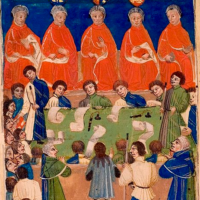For the past few months I’ve been serving as an expert witness in a case somewhere about something. I can’t and won’t tell you anything at all about it. However this experience has given me a chance to reflect on academic expertise and its applications within the justice system. Having just compiled another report, I am thinking about the vast amount of real, interesting, and certainly publishable research that goes in to expert witnessing. Work that perhaps may never be seen out of a court due to post-case barriers to publication.
Back in Nov 2020 I reviewed Richard E. Spear’s “Caravaggio’s Cardsharps on Trial” for this blog. It was a long book but I was rapt. Spear is an art historian and Caravaggio expert and the book is a combination of both his research into a particular painting as part of a civil case and his own experience being an expert witness in that case. It is a rare look at an art-focused court case written by a non-lawyer who was still on the inside of it. All the work that Spear put in to evaluating the painting, as well as evaluating other evaluations of the piece, was preserved. It was published and shared. Is this an outlier?
Most scholarship we academics produce is done within the context of our academic jobs, funded by our university or funding agency, and has a clear pathway to publication. Publication is incentivised! It is in the public interest! Some academics do research commissioned by governmental bodies or private companies that may or may not be shared, particularly if it has a commercial aspect, but in those instances the particulars of the deal are in the contract signed. Especially for the commercial research, the work isn’t usually being done “in the public interest” anyway. It is an aspect of business.
I’m struggling, however, with how to place research conducted in the course of civil and criminal proceedings. The research conducted for the courts is done, inherently, in the interest of the public. It is done to shed light on important aspects of possible crimes, civil violations, etc. The results may have applications in other cases, or may shed light on wider social structures that need to be addressed on a policy level. It also might just be good and interesting scholarship in a disciplinary sense.
Yet it exists in a liminal space, protected to some extent by promises not to disclose (…until when? what are the limits?), fears of spoiling a particular case (which may go on a very long time), and the lack of experience many academic have with the legal system. The final one I think is important as even in cases where there would be no problem publishing the results of research conducted, academics may rightly feel that the legal system is terrifying, they don’t understand it, and that it is better to say nothing rather thanviolate some rule somewhere.
Once again, I will not tell you anything at all about the case I am expert witnessing for: it is certainly active and ongoing. However I can tell you that I’ve put a significant amount of thought and work into my reports, and I have truly enjoyed doing it. The case itself has allowed me to structure my thinking about the issues and locations in question in what I think is a useful way, and I could easily convert it all into an academic paper in a day or two. The particulars of the case have allowed me to refine my thinking about certain issues and given me the opportunity to build (what I think) are well supported responses to those issues that have further applications. I want to share this work!
But it may never happen. You all may never see any of this. My work may remain confidential or sealed forever. I hope it won’t but it is certainly a possibility. I don’t have enough experience with the court system in question to know what is usually allowable after a case is resolved. I’m going to find out, of course, but for now I am stuck doing exciting work that I may never be able to share.
